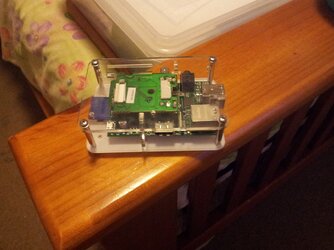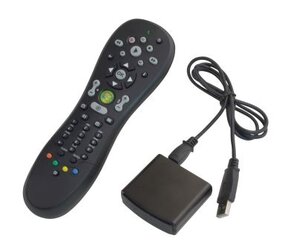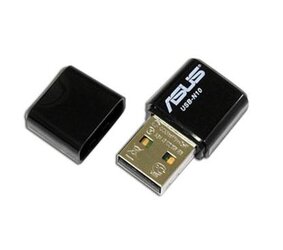- Joined
- Nov 11, 2010
Prefece: Still working on my setup so this is an incomplete "review". Will update as changes occur.
I received my Raspberry Pi earlier this week and here are my initial impressions.
It doesn't look like much when you first remove it from the packaging. That's mainly due to the board lay-out, which is clean and barren of any non-essential items. As is sometimes the case, however, looks can be deceiving.
Raspberry Pi

The following ports are available:
HDMI (Sound over HDMI is enabled)
Ethernet (10/100)
2x USB 2.0
Composite video
Analog Audio
I hopped online and grabbed the latest stable build of Raspbian and burned the image to an SD Card. then I assembled the various bits, gathered and connected the appropriate cables, and powered up the unit for the first time.
I ran the Ethernet to the cable modem because there is a compatibility issue that exists between the Pi and my DGL-4100 Router. Once bypassed, The RPi hits the internet just fine.
I ran the HDMI (Sound over HDMI enabled by default in XBMC) to my 46" Samsung
I ran 1 USB Cable to the Dell 2407FWP USB Hub/6in1 Card Reader. This allows me to use the 4 USB ports on the hub (it acts as a powered 4 port hub) and I can use the card readers to expand my storage.
I ran the micro USB power cable to my Droid 1 charger brick. The Raspberry Pi runs on 5v at 1A so a phone charger is plenty sufficient.
Boot Times
Raspbian - It was nothing to write home about, but it was by no means so slow as to elicit complaints. It boots faster than my phone so I find its performance in this area completely acceptable. Offers the user the ability to configure several different aspects of the system's operation on the first boot. This is a nice touch. Since this is not a review of the OS, let's just skip to the next OS
Arch Linux - Noticeably faster boot time. Boots to the command line like Raspbian but, unlike Raspbian, does not give you the option to boot to X upon startup.
XBMC - 23 seconds from power on to desktop. Interesting OS. When you download the XBMC image, it is not the final image. You burn the image to SD Card and, once the RPi boots up with that image, it downloads the rest of the needed code and builds the OS for you.
Problems Encountered
1 - Networking -- Network initially kept dropping out due to the USB issue mentioned on the Raspberry Pi forums.
2 - Internet Connectivity -- Once Networking was corrected, I could not access the internet. Okay...this should be simple. I just need to add my RPi's MAC Address to the MAC Filtering Table on my DGL-4100, right? Nope. I was never able to resolve the issue. The RPi and D-Link had no interest in peacefully coexisting. No matter what settings I changed, the RPi and D-Link DGL-4100 would not communicate and establish a connection. Bypassing the Router fixed the internet connectivity issue immediately.
3 - Choice -- With three now-working Distros to choose from, I found myself waffling. I'd work in 1 distro for 20 minutes then hop over to one of the others...
Performance
Performance-wise, the unit is totally acceptable. I've seen its performance described as "...like a P2-300 with awesome graphics". I'd say that's a pretty close to accurate description. Closer still would be roughly a PII-400, IMHO. I noticed some lag here and there, but it is totally acceptable to me.
Performance when viewing HD video is superb. Every bit as good as watching Cable HDTV. Sound over HDMI is enabled by default and it "just works", at least in Raspbian and XBMC. I did not get far enough in ArchLinux to see if it worked properly.
Pics
My Remote/Keyboard (Re-Used from my Asus F1A75-I Deluxe)


XBMC



I received my Raspberry Pi earlier this week and here are my initial impressions.
It doesn't look like much when you first remove it from the packaging. That's mainly due to the board lay-out, which is clean and barren of any non-essential items. As is sometimes the case, however, looks can be deceiving.
Raspberry Pi

The following ports are available:
HDMI (Sound over HDMI is enabled)
Ethernet (10/100)
2x USB 2.0
Composite video
Analog Audio
I hopped online and grabbed the latest stable build of Raspbian and burned the image to an SD Card. then I assembled the various bits, gathered and connected the appropriate cables, and powered up the unit for the first time.
I ran the Ethernet to the cable modem because there is a compatibility issue that exists between the Pi and my DGL-4100 Router. Once bypassed, The RPi hits the internet just fine.
I ran the HDMI (Sound over HDMI enabled by default in XBMC) to my 46" Samsung
I ran 1 USB Cable to the Dell 2407FWP USB Hub/6in1 Card Reader. This allows me to use the 4 USB ports on the hub (it acts as a powered 4 port hub) and I can use the card readers to expand my storage.
I ran the micro USB power cable to my Droid 1 charger brick. The Raspberry Pi runs on 5v at 1A so a phone charger is plenty sufficient.
Boot Times
Raspbian - It was nothing to write home about, but it was by no means so slow as to elicit complaints. It boots faster than my phone so I find its performance in this area completely acceptable. Offers the user the ability to configure several different aspects of the system's operation on the first boot. This is a nice touch. Since this is not a review of the OS, let's just skip to the next OS
Arch Linux - Noticeably faster boot time. Boots to the command line like Raspbian but, unlike Raspbian, does not give you the option to boot to X upon startup.
XBMC - 23 seconds from power on to desktop. Interesting OS. When you download the XBMC image, it is not the final image. You burn the image to SD Card and, once the RPi boots up with that image, it downloads the rest of the needed code and builds the OS for you.
Problems Encountered
1 - Networking -- Network initially kept dropping out due to the USB issue mentioned on the Raspberry Pi forums.
2 - Internet Connectivity -- Once Networking was corrected, I could not access the internet. Okay...this should be simple. I just need to add my RPi's MAC Address to the MAC Filtering Table on my DGL-4100, right? Nope. I was never able to resolve the issue. The RPi and D-Link had no interest in peacefully coexisting. No matter what settings I changed, the RPi and D-Link DGL-4100 would not communicate and establish a connection. Bypassing the Router fixed the internet connectivity issue immediately.
3 - Choice -- With three now-working Distros to choose from, I found myself waffling. I'd work in 1 distro for 20 minutes then hop over to one of the others...
Performance
Performance-wise, the unit is totally acceptable. I've seen its performance described as "...like a P2-300 with awesome graphics". I'd say that's a pretty close to accurate description. Closer still would be roughly a PII-400, IMHO. I noticed some lag here and there, but it is totally acceptable to me.
Performance when viewing HD video is superb. Every bit as good as watching Cable HDTV. Sound over HDMI is enabled by default and it "just works", at least in Raspbian and XBMC. I did not get far enough in ArchLinux to see if it worked properly.
Pics
My Remote/Keyboard (Re-Used from my Asus F1A75-I Deluxe)


XBMC














